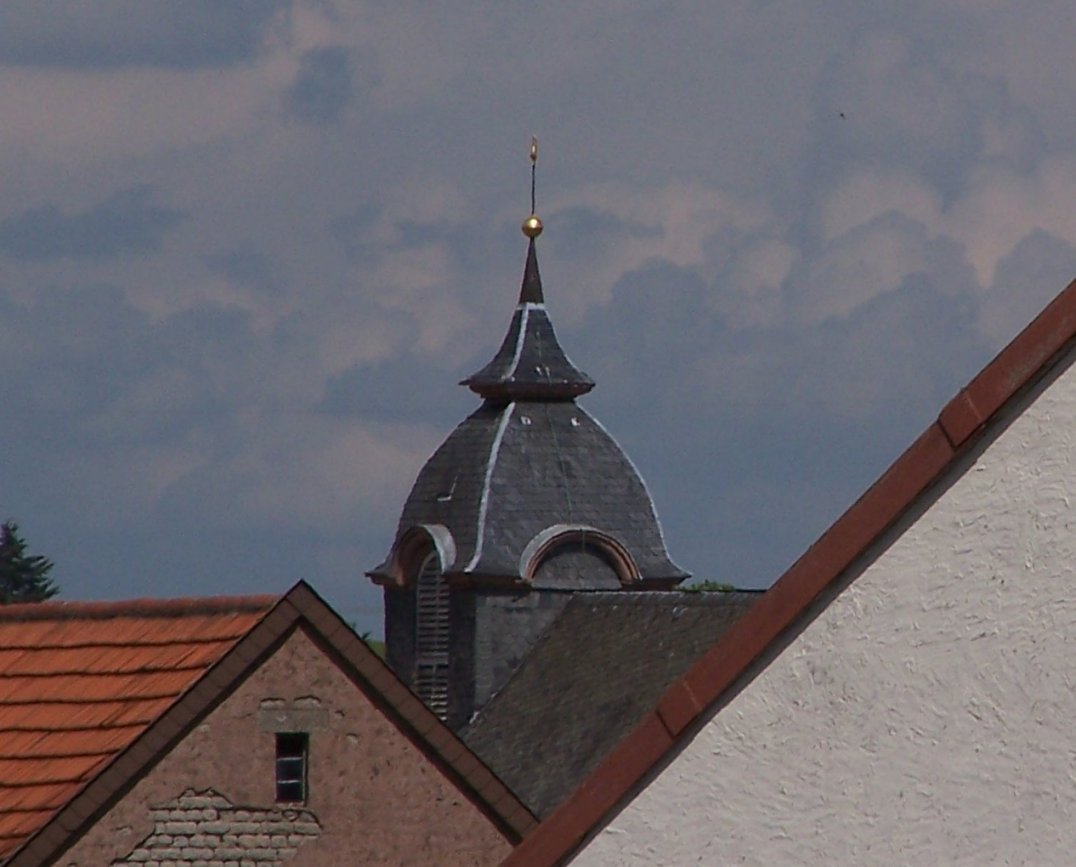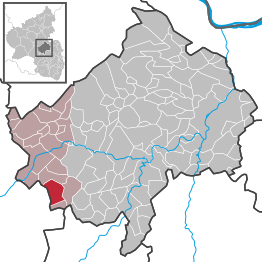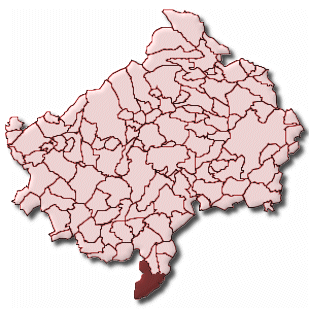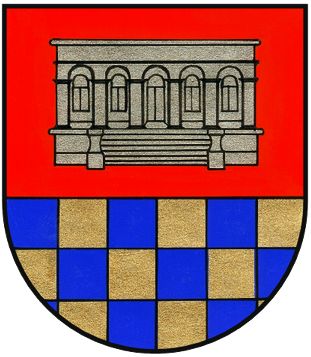Becherbach (Bad Kreuznach)
Becherbach is a municipality in the district of Bad Kreuznach in Rhineland- Palatinate. It belongs to the municipality Meis home.
- 3.1 municipal
- 3.2 Mayor
Geography
Becherbach located south of Meis home in the Palatinate.
Districts are the villages Becherbach (about 550 inhabitants), Gangloff ( about 275 inhabitants) and Roth ( about 275 inhabitants). The hamlet Becherbach includes the residential places Kirnbuscherhof, Römerhof and Rothenbaumerhof.
History
Neolithic remains have been found in Gangloff and Roth. The Roman road connecting Bad Kreuznach Otter mountain led through the Rossberg at Becherbach and Gangloff. A leading after Odenbach turn led past between Becherbach and Roth, extending in this way area is still called " Roman road ". At the top of the Rossberg two rectangular stones that Mercurius and his mother Maia were consecrated, and two Roman coins and bricks were found, including stamp. These findings are all lost. In the village church they found a Roman grave, in the cemetery of Gangloff a four gods of stone. In Roth no Roman remains have been found.
The whole of modern municipality was under the rule of the Counts of Veldenz, after the extinction of the Wittelsbach ( Duchy of Pfalz- Zweibrücken and the Kingdom of Bavaria ).
For a long time was Becherbach on the border of two states: Meis home that Becherbach was superior as the administrative headquarters had previously been temporarily ( as again today ), was between the Congress of Vienna in 1815 and reorganization of Germany to countries in 1946 to Prussia or before 1866 to Hesse -Homburg. The border was thus only about 7-9 km from the now belonging to the local community villages.
The NSDAP group in Becherbach was founded in October 1927 by Emil Gauer. The election results were the NSDAP 1928-1933 above the average of the empire. The antisemitic newspaper "Der Stuermer" wrote in April 1936, the population of Odenbach, Becherbach and the surrounding area was still " highly boarded up and behind the moon at home " in the " Jewish Question" in part. The occasion was the funeral of a Odenbacher Jew who had been visited by different ( mentioned by name ) inhabitants of the places mentioned.
1954 got Becherbach the first water line, which was the first step towards "modernization" of the small village.
Today's local church Becherbach was on 7 June 1969 formation of the previously independent municipalities Becherbach / Pfalz (532 inhabitants), Gangloff (270) and Roth ( 274). At the same time was the spin-off from the district of Kusel, and the reassignment to the district of Bad Kreuznach.
On 22 January 2011, the entire population had to be evacuated, as in a barn next to machine guns and hand grenades large amounts of explosives were found. According to a police spokesman, it was " probably " the largest quantity of explosives that was nationwide ever found at a private citizen.
Mine being
Under Duke Wolfgang of Pfalz- Zweibrücken, the so-called " Odenbacher seam " (coal ) was discovered in 1546, which was sponsored, among others, in Reiffelbach. In the church today Becherbach this raw material was mined only in the villages Gangloff and Roth. The mine in Roth stood with his Odenbacher mine through a passageway in communication, one close to Roth in the ( Hollerbach ) was in contact with the Reiffelbacher mine. Among themselves there were between the villages of today's local church Becherbach no connecting corridors. In the district Becherbach a pure chalk mine on the southern slopes in 1799 operated in the direction Reipoltskirchen.
Religions
The inhabitants are predominantly Protestant.
Becherbach Since 1975, the parish Odenbach, which in turn - is the Evangelical Church of the Palatinate assigned - as one of the northernmost communities.
Policy
Parish council
The local council in Becherbach consists of twelve council members, who were elected at the municipal election held on 7 June 2009 by majority vote, and the honorary mayor as chairman.
Mayor
Mayor Wolfgang Paul (SPD; 1991-2009 ); Manfred Denzer (SPD and from 2009 ).
Others
- The name " Becherbach " probably comes from the pitch torches ( Middle High German and Palatine cup, Becherer plural ) who worked there before. The name " Gangloff " comes from St. Gangolf; in Germany quite a common name "red " indicates a clearing.
- The coat of arms mug Bach in 1952 from a symbol of the namesake cup of Bach, the Pecher, the pitch basket, and the colors of Palatinate -Zweibrücken, red and gold. An unofficial coat of arms consists of a Roth standing on a three mountain tree and two crossed mining hammers left and a ploughshare right while Gangloff in the arms of the resident bagpiper Association " St. Gangolf Pipes & Drums " with a picture of St. Gangolf, a horse is symbolized for the area between Becherbach and Gangloff Rossberg and a sacred well.
- The only major non-church festival in Becherbach is the " notch " that from Friday to Monday - is celebrated the first weekend of September - with a parade on Sunday. The other districts have their own notch at about the same time.
- Becherbach is often confused with the similarly located in the district of Bad Kreuznach cup bei Kirn.
- Gangloff has an independent football club, which is also active in youth work.


_CoA.svg/79px-Becherbach_(Pf)_CoA.svg.png)





